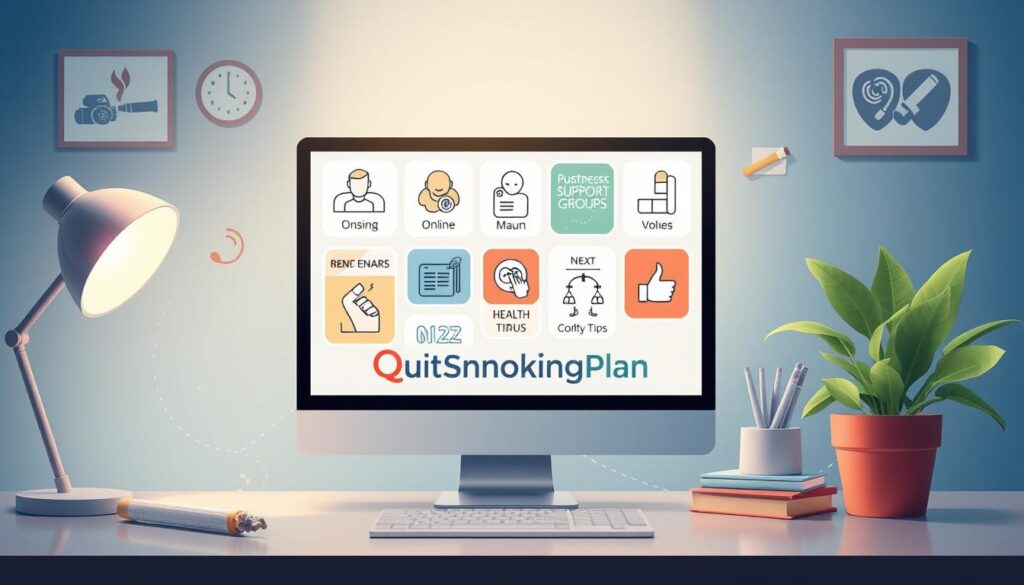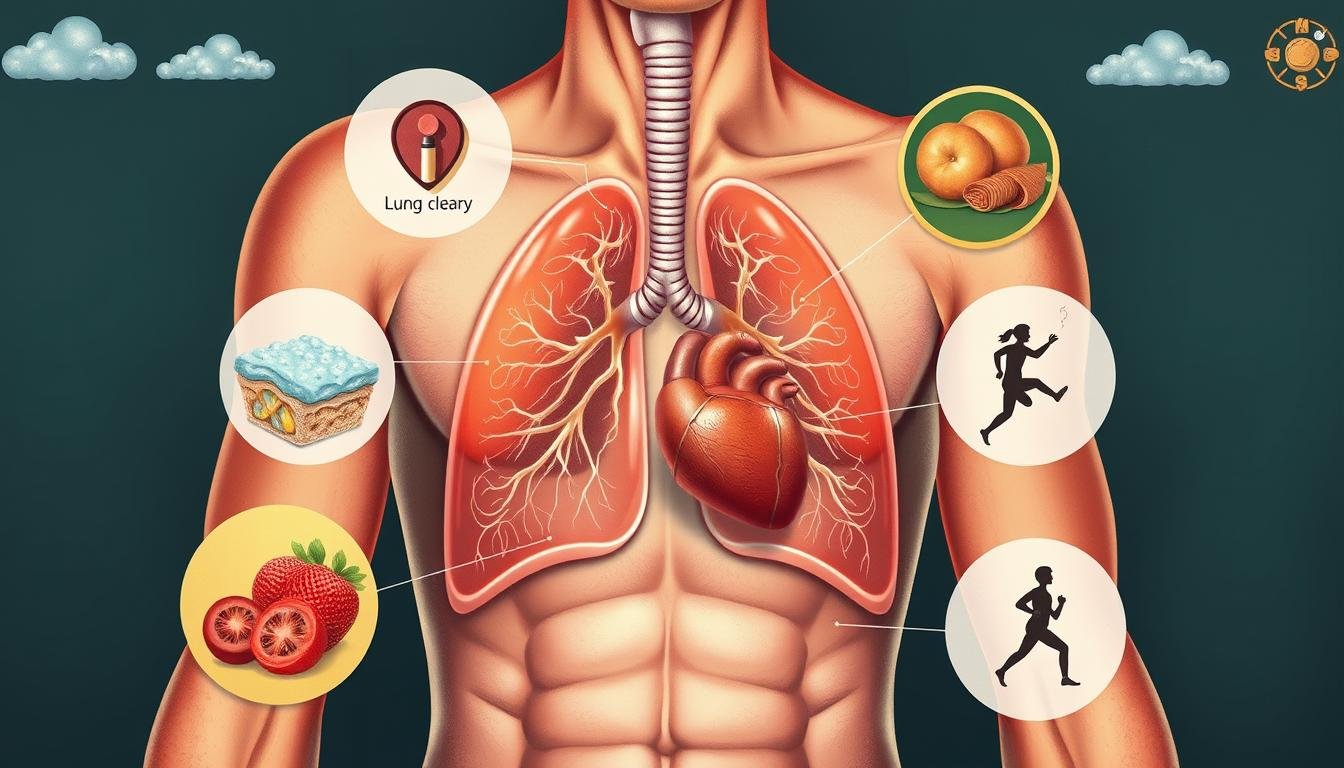Ever thought about how the right quit smoking resource could help you kick the habit? Starting your journey to a smoke-free life is exciting. But, it’s important to know that not all quit smoking help is the same. You have many options like healthcare, support groups, medications, and online tools.
It’s never too late to quit smoking. Every step you take towards quitting can greatly improve your health. For example, studies show that strong social support can help you quit and stay smoke-free1. Also, nicotine replacement therapy can almost double your chances of quitting2.
As you look for help, remember there’s something for everyone. Taking that first step is a big move towards a healthier future.
Key Takeaways
- Identifying effective quit smoking resources tailored to your needs is essential.
- Social support significantly increases the likelihood of successfully quitting.
- Nicotine replacement therapy can enhance your chances of quitting.
- Multiple methods, such as counseling and support groups, can aid your quitting process.
- Don’t underestimate the importance of preparing before your Quit Day.
Understanding the Importance of Quitting Smoking
Quitting smoking is crucial for your health and the health of others. It can greatly improve your health and lower the risk of many diseases. If you stop smoking before 50, you cut your risk of dying in the next 15 years by half3.
After quitting, your risk of lung cancer halves in ten to fifteen years. Your risk of heart disease gets close to that of a non-smoker in fifteen years4. These facts show why quitting is so beneficial.
Smoking also costs a lot in healthcare and causes big health problems. It’s a major cause of deaths worldwide, linked to heart disease, lung cancer, and breathing issues5. Adults exposed to secondhand smoke face serious health risks. Children breathing it may get asthma or SIDS3.
By quitting, you protect your health and the health of those around you from secondhand smoke.
The Impact of Smoking on Your Health
Smoking has a big impact on your health, leading to serious issues. People who smoke are at a higher risk of chronic obstructive pulmonary disease (COPD) and different cancers. Smoking is the main cause of cancer and death from cancer in the country6. It can cut your life short by at least ten years6.
Smokers are 12 to 13 times more likely to die from COPD than those who don’t smoke6.
Smoking also affects those around you. Secondhand smoke is dangerous for non-smokers, raising their risk of heart disease and lung cancer6. Smokers are two to four times more likely to get heart disease and stroke than non-smokers6. Even a little smoking can lead to early heart disease, showing that any smoking is risky6.
But quitting smoking can greatly improve your health. Quitting early can cut your risk of dying from smoking-related diseases by about 90% if you quit before 407. Quitting can add up to ten years to your life compared to smoking7. Quitting also brings quick benefits like better taste, smell, and breath, and a healthier look7.

| Health Impact | Risk Level for Smokers | Risk Level for Non-Smokers |
|---|---|---|
| Chronic Obstructive Pulmonary Disease (COPD) | 12–13 times higher | Base risk |
| Coronary Heart Disease and Stroke | 2-4 times higher | Base risk |
| Risk of Developing Cancer | Significantly elevated | Lower risk |
| Life Expectancy Reduction | At least 10 years | No reduction |
| Risk of Premature Death | Leading cause | Non-leading cause |
Deciding to Quit: Your First Step
Deciding to quit smoking is a big step towards a healthier life. Knowing the benefits of quitting is key to staying motivated. Once you decide to quit, you start your journey to a better life.
About 60% of smokers over 60 get help to quit through programs like Smokefree 60+ from the National Cancer Institute8. This shows that many people, no matter their age, can get help to quit.
Recognizing the Benefits of Quitting
Highlighting the benefits of quitting can really motivate you. Almost 70% of smokers want to quit9. Quitting can improve your health, increase your life span, and make life better overall.
Setting milestones, like celebrating 24 hours or 1 week without smoking, can help you see your progress8. When you see these benefits, it’s easier to stay on track towards a healthier life.
Overcoming Mental Barriers to Quitting
Many people face mental barriers when trying to quit smoking. Fears about withdrawal, cravings, and addiction to smoking can slow you down. It’s important to know these challenges to overcome them.
Only 7.4% of smokers quit each year9, showing the need for determination. Using aids like gum or patches and getting support from loved ones can help you succeed9.
Identifying Your Reasons to Quit
Knowing why you want to quit smoking is key to success. Setting personal health goals can boost your determination. Seeing the health benefits can improve your life quality.
Personal Health Goals and Aspirations
Your personal health aspirations might include avoiding chronic diseases or getting fit. Quitting smoking can make you healthier at any age. It cuts down on health problems like colds and breathing issues, leading to fewer doctor visits10.
Also, quitting can save you money. A pack-a-day smoker can save about $2,900 a year. This money can go towards healthier activities10.
Impact on Family and Friends
Smoking affects your loved ones deeply. Secondhand smoke harms their health. This can cause stress in family and social life10.
Quitting makes your home healthier for them. It also shows your dedication to health.

For more help, check out the American Lung Association’s Freedom from Smoking. It offers great advice to help you quit here11.
Types of Quit Smoking Resources Available
Quitting smoking is tough, but many resources can help. Combining counseling and medications is the best way to quit for good12. Over half of U.S. adults who smoked have quit, showing these tools work12.
There are many tobacco cessation tools to fit your needs. Here are some common ones:
- Counseling Services: Personal support through counseling can help you overcome quitting challenges.
- Quitlines: Hotlines like the American Heart Association (1-800-AHA-USA1) and the American Cancer Society (1-800-ACS-2345) offer quick help13.
- Mobile Applications: Apps help track your progress and offer encouragement while quitting.
- Literature and Guides: Printed materials provide valuable info on quitting smoking.
Nicotine Replacement Therapy (NRT) is a common choice. It includes patches, gum, lozenges, inhalers, and nasal sprays12. Using different NRT forms can increase your chances of quitting12. Prescription medications like Varenicline and bupropion are also effective, but talk to your doctor about side effects1213.
There are also hotlines for specific groups. The Asian Smokers Quitline offers support in many languages. Veterans can call 1-855-QUIT VET, and Canadians can reach out at 1-866-366-3667 for English or 1-866 JARRETE for French13.
Using these diverse resources can give you the support you need to quit smoking.
Quit Smoking Resource: How to Choose What’s Right for You
Choosing the right quit smoking resources can be tough. You need to think about your habits and past attempts to quit. Look for methods that include counseling, medication, and lifestyle changes.
Many people find success with counseling services like NCI’s Smoking Quitline at 1–877–44U–QUIT (1–877–448–7848). It offers personalized help and other services to help you quit. It’s available Monday through Friday from 9:00 a.m. to 9:00 p.m., Eastern time14. The Smokefree.gov website also offers support in English and Spanish through LiveHelp, an online chat service, available during the same hours14.
State quitlines are another good option. By calling 1–800–QUIT–NOW (1–800–784–8669), you can get personalized help. These lines connect you with state-run quitlines that offer free help and support services across the United States14.
It’s important to find resources that fit your needs. Smokefree.gov has many publications, like Clearing the Air for smokers trying to quit and Clear Horizons for those over 5014. You can also talk to healthcare professionals who know about smoking risks and benefits. They can help with nicotine replacement and medication15.
Effective quit smoking methods often use many approaches. Consider using tools for healthcare providers, like tobacco cessation toolkits and practice manuals15. These can help you and your healthcare provider create a plan that’s just right for you.
Lastly, try interactive quizzes and community programs to see if you’re ready to quit. They can help you understand your motivations and readiness. This ensures you have a solid plan for quitting smoking.

| Resource | Description | Contact Information |
|---|---|---|
| NCI’s Smoking Quitline | Individualized counseling and support to help quit smoking. | 1–877–44U–QUIT (1–877–448–7848) |
| Smokefree.gov | Support in English and Spanish via online messaging. | Visit Smokefree.gov |
| State Quitlines | Personalized help with cessation and local program referrals. | 1–800–QUIT–NOW (1–800–784–8669) |
Consulting Healthcare Providers for Personalized Guidance
Getting help from a healthcare provider is key when you want to stop smoking. They know a lot and can make plans just for you. They can also help you deal with the tough parts of quitting.
How Providers Can Assist in Your Journey
Healthcare providers are big helpers when you try to quit smoking. They check your health and suggest the best ways to quit. They might talk about ways to handle cravings and even suggest medicines to help.
Studies show that plans made just for you can make quitting easier and save money16. Getting help like this makes you more likely to succeed.
Creating a Customized Quit Plan
Working with a healthcare provider to make a quit plan is very helpful. A good plan includes setting a quit date, knowing your triggers, and having a support system. Counseling can be part of this plan, and it might even be free with insurance17.
Using things like nicotine replacements can also help. This way, you get a plan that fits your life and what you like.
With a detailed plan, you’re ready to face the challenges of quitting. Don’t forget to use the help from your healthcare provider. They are a big part of your journey to a smoke-free life. Being fully involved in this process can make you more likely to succeed and improve your health18.
Behavioral Support: Joining Support Groups
Being part of smoking cessation support groups is a big help for those trying to quit smoking. These groups offer a sense of belonging, which is key during the tough quitting journey. People often feel more driven and supported by sharing experiences and tips.
Studies show that group therapy for quitting smoking really works. For example, a study found that group therapy boosts quitting rates by 88% compared to self-help19. Also, group programs are better than brief support from doctors, increasing quitting rates by 22%19. These numbers show how helpful group support can be in making lasting changes.
People with mental health issues smoke a lot more, with about 33.3% being current smokers20. Support groups can help these individuals face their unique challenges. Quit rates for those with mental health issues are 34.7%, compared to 53% for those without20. This shows how crucial support is in mental health settings.
Using programs like the EX Program can boost quitting chances by up to 40%21. The EX Program Premium can even help up to 52% of users quit when they follow the best practices21. These tools help people find the community and help they need to quit smoking successfully.

- Types of Support Available:
- In-person support groups
- Online support communities
- Specialized groups for those with mental health disorders
- Benefits of Joining:
- Increased motivation through peer support
- Access to shared resources and strategies
- A feeling of belonging during the quitting process
By joining a smoking cessation support group, people can get more help in quitting. Quitting becomes easier with a supportive group that encourages progress and shares tips.
Understanding Different Smoking Cessation Tools
Finding the right tools to quit smoking can really help. There are many aids to manage cravings and symptoms. We’ll look at nicotine replacement and non-nicotine medications.
Nicotine Replacement Aids
Nicotine therapy is key in quitting. Patches, gums, lozenges, and inhalers help control cravings. Studies show they can double your chances of quitting22.
Patches release nicotine all day, helping with cravings23. For quick relief, gum can be used every hour or two. You can chew up to 24 pieces a day23.
The lozenge offers similar benefits but might irritate your mouth. The inhaler allows controlled dosing but can irritate your mouth or throat23. The nasal spray works fast but needs a prescription and can irritate your nose and throat23.
Using these aids with counseling or support programs boosts your chances of quitting23.
Non-nicotine Prescription Medications
Prescription medications like Bupropion and Varenicline can help you quit. Bupropion, an antidepressant, reduces cravings and withdrawal symptoms. It also helps prevent weight gain after quitting23.
Varenicline blocks nicotine receptors and reduces cravings. However, it may cause nausea and insomnia23. These medications work best with nicotine therapy and professional support23.
Online Resources and Support Groups
In today’s digital age, you can find many online quit smoking resources. These offer crucial support for those trying to quit. Virtual support communities let you get help anytime, keeping your identity private. This can encourage more people to join in.
These platforms help you connect with others facing similar challenges. This support can make your quitting journey richer.
Benefits of Virtual Support Communities
Virtual support for quitting smoking has many benefits. You can find people who understand your struggles, offering encouragement and motivation. Online resources are available anytime, not just during work hours.
This makes it easier to get help when you need it most. Many platforms welcome everyone, no matter their language. This makes quitting smoking efforts more effective and inclusive.
Online Quit Smoking Programs
Online quit smoking programs offer structured help tailored to your needs. Studies show these programs can double or triple your chances of quitting. You can find counseling, self-help materials, and local service referrals online.
The Tobacco Education Resource Library has over 90 motivational posters and educational content in English and Spanish. These materials help you understand the health benefits of quitting and the dangers of vaping nicotine. Online programs offer a holistic approach to help you quit.

Exploring Smoking Cessation Programs
Choosing the right smoking cessation program is key to quitting smoking for good. A good program should offer many features to help you beat your addiction. Here are important things to look for in quality cessation programs.
What to Look for in a Good Program
When looking at smoking cessation programs, consider these points:
- Look for counseling services, which have shown to be very helpful.
- Check if they offer nicotine replacement therapy (NRT) to help with withdrawal symptoms24.
- See if they use combination therapies, like therapy and medication together, which work better25.
- Make sure they have resources for everyone, including those from the VA.
Evidence-Based Approaches for Success
Successful quit strategies rely on evidence-based methods. Programs that use these methods often include proven behavioral therapies. For example, combining therapy with medication can lead to a 24% success rate in a year25.
Using products like varenicline with behavioral support can increase success even more, reaching a 44% abstinence rate in four weeks25. This shows that a multi-faceted approach is crucial for quitting.
Effective Quit Smoking Techniques and Strategies
Quitting smoking needs a plan that includes many strategies. Setting a quit date is key. It gives you a clear goal and time frame to become tobacco-free.
Try tapering off cigarettes to reduce nicotine dependence. This lets your body get used to less nicotine over time. Mindfulness and relaxation, like deep breathing or yoga, can help manage cravings and stress.
Dealing with cravings and stress is crucial. Nicotine replacement therapies, like patches and gums, can help. These cravings usually last 5 to 10 minutes and will pass, whether or not you smoke26.
Having support from friends, family, or online groups is important. The Lung HelpLine is there to help you quit27. The Freedom From Smoking program by the American Lung Association offers valuable strategies and guidance27.
Using a mix of quitting strategies can lead to better success. For example, combining medication with behavioral therapy can increase your chances of quitting. This approach can lead to a success rate of about 24% within a year25. Without a plan, quitting can be much harder.

Developing Your Own Quit Smoking Plan
Creating a personalized quit smoking plan can greatly improve your chances of success. It’s important to tailor your approach to your unique triggers and circumstances. Start by identifying what makes you want to smoke. Knowing these triggers can help you come up with effective quit strategies.
Building a strong support system is key. Having family and friends by your side can make a big difference. Studies show that about 60% of people find quitting easier with support from loved ones8. Their encouragement can help create a positive environment as you move forward.
Setting realistic goals is crucial. Choose a quit date that fits your lifestyle and needs. Remember, most relapses happen in the first three months after quitting28. Knowing this can help you prepare for any setbacks and stay strong.
When making your quit plan, consider using medications if needed. The U.S. Food and Drug Administration has approved six medications to help quit smoking28. Nicotine replacement therapy can double your chances of quitting for good8. These resources can offer the extra support you need during tough times.
Your plan should grow and change as you progress. Regularly check and adjust your plan to keep it effective and relevant to your life. Being flexible will help you overcome quitting challenges and stay focused on your goals.
Overcoming Relapse: What to Do When You Slip Up
Dealing with relapse is a common challenge when trying to quit smoking. Many people need to try quitting several times before they succeed. This shows that relapses are a big part of the quitting process29. If you slip up, it’s important to figure out what caused it. Knowing your triggers can help you avoid relapse in the future.
Cravings usually last between 10 to 20 minutes. Knowing this can help you get through the urge to smoke29. Withdrawal symptoms get worse in the first 2-3 days after quitting. This can make you feel like you’ll never quit, but it’s just a phase29.

Learning from Setbacks
Think about what happened to learn from it. Most people don’t quit the first time, and that’s okay30. Seeing each attempt as a step closer to quitting can motivate you. People with strong support systems are more likely to quit and stay quit, so don’t be afraid to ask for help30.
Staying Motivated After a Relapse
Remember why you wanted to quit in the first place. Getting involved in support groups or counseling can give you the motivation you need31. It’s okay to admit when you slip up, but focus on the small victories. Every success brings you closer to a smoke-free life30. Staying proactive about managing cravings and seeking help is key to quitting for good29.
| Key Strategies | Description |
|---|---|
| Identify Triggers | Recognize the moments or situations that increase your urge to smoke. |
| Use Support Resources | Engage with friends, family, or support groups who understand your journey. |
| Consider Medical Support | Look into medications like Chantix to help prevent relapse31. |
| Set New Goals | Establish clear and achievable goals to redirect your focus towards quitting. |
| Practice Patience | Understand that quitting is a process, and setbacks are a part of the journey. |
Stop Smoking Tips for Long-Term Success
Staying smoke-free needs commitment and smart strategies. One key tip is to avoid things that make you want to smoke. Knowing and avoiding these triggers helps you stay strong against the urge to light up.
It’s also helpful to keep reminding yourself why you quit. Writing down your reasons can be a powerful tool. It helps you remember the health benefits and longer life you’ll gain, which can start within 20 minutes of quitting32.
Having a strong support network is crucial. Friends, family, or groups can offer the motivation you need. Using resources like the American Lung Association’s Freedom From Smoking can provide valuable advice and tools. Combining support with medication, like nicotine replacement, can lead to better success rates32.
Being mindful of cravings is key. Making a quit plan with short-term goals and celebrating small wins can help a lot. Quitting smoking also reduces risks of cancer, heart disease, and lung problems33
| Strategies | Benefits |
|---|---|
| Avoiding triggers | Reduces the risk of relapse |
| Regular motivation reviews | Reinforces commitment to quit |
| Support systems | Provides encouragement and accountability |
| Setting quit dates | Increases chances of successful cessation |
| Integrating behavioral therapy | Doubles chances of quitting successfully |
Remember, withdrawal symptoms are tough but short-lived. Getting help from established programs can greatly aid your journey. You have the power to change your life and reach your goals with the right strategies34.
Conclusion
Starting your journey to quit smoking is tough but can change your life. Using different quit smoking resources helps you find what works best for you. In 2018/2019, about 33.7% of adults who smoked used treatments to help them quit35.
Quitting smoking can greatly improve your health. It can make your blood flow better and lower your cancer risk. But, just switching to e-cigarettes isn’t enough to quit for good36. Think about using both behavioral and medicine-based methods for a complete plan.
Quitting smoking is a tough road, but it’s possible. Using the right strategies and support can make you more likely to succeed. It also lowers the risks of smoking-related health problems. Remember, you’re not alone. Many quit smoking resources are here to help you on your path to a healthier life with proven methods and support.
FAQ
What are some effective quit smoking resources available to me?
Why is quitting smoking important for my health?
What are common health issues caused by smoking?
How can I find motivation to quit smoking?
What types of support are available for quitting smoking?
How can I create a personalized quit smoking plan?
What should I do if I experience a relapse?
Are there online resources available to help me quit smoking?
What are nicotine replacement aids and how do they help?
Can non-nicotine medications assist in quitting smoking?
Source Links
- https://www.cancer.org/cancer/risk-prevention/tobacco/guide-quitting-smoking.html
- https://www.cancer.org/cancer/risk-prevention/tobacco/guide-quitting-smoking/deciding-to-quit-smoking-and-making-a-plan.html
- https://www.uptodate.com/contents/quitting-smoking-beyond-the-basics
- https://www.cdc.gov/tobacco/about/benefits-of-quitting.html
- https://tabhealth.org/importance-of-quitting-smoking/
- https://veterans.smokefree.gov/reasons-quit/smoking-affects-health
- https://www.cancer.org/cancer/risk-prevention/tobacco/guide-quitting-smoking/benefits-of-quitting-smoking-over-time.html
- https://60plus.smokefree.gov/sites/default/files/2020-07/Print Resources_Smokefree_60plus_Quit_Plan.pdf
- https://truthinitiative.org/research-resources/quitting-smoking-vaping/10-steps-successfully-make-plan-quit-smoking
- https://www.cancer.org/cancer/risk-prevention/tobacco/reasons-to-quit-smoking.html
- https://smokefree.ucsd.edu/resources-to-quit/index.html
- https://www.cdc.gov/tobacco/about/how-to-quit.html
- https://www.heart.org/en/healthy-living/healthy-lifestyle/quit-smoking-tobacco/help-i-want-to-quit-smoking
- https://www.cancer.gov/about-cancer/causes-prevention/risk/tobacco/help-quitting-fact-sheet
- https://www.aafp.org/family-physician/patient-care/care-resources/tobacco-and-nicotine/tobacco-tools.html
- https://pivot.co/blog/customized-smoking-cessation-program
- https://www.virtua.org/Services/Pulmonology/Smoking-Cessation-Programs
- https://www.cigna.com/knowledge-center/hw/quit-smoking-programs-aa153314
- https://pmc.ncbi.nlm.nih.gov/articles/PMC6464070/
- https://www.aafp.org/family-physician/patient-care/care-resources/tobacco-and-nicotine/office-champions/behavioral-health-tobacco-cessation.html
- https://truthinitiative.org/exprogram
- https://smokefree.gov/tools-tips/get-extra-help/free-resources
- https://www.mayoclinic.org/healthy-lifestyle/quit-smoking/in-depth/quit-smoking-products/art-20045599
- https://www.mentalhealth.va.gov/quit-tobacco/how-to-quit.asp
- https://pmc.ncbi.nlm.nih.gov/articles/PMC10858725/
- https://www.mayoclinic.org/healthy-lifestyle/quit-smoking/in-depth/nicotine-craving/art-20045454
- https://www.lung.org/quit-smoking/i-want-to-quit/top-tips-for-quitting-smoking
- https://www.nvfc.org/wp-content/uploads/2020/06/Heart-Healthy-Firefighter-Smoking-Cessation.pdf
- https://mainequitlink.com/thinking-about-quitting/prevent-a-slip-or-relapse/
- https://www.cancer.org/cancer/risk-prevention/tobacco/guide-quitting-smoking/helping-a-smoker-quit.html
- https://utswmed.org/cancer/support-services/education-resources/support-loved-one-quit-smoking/
- https://www.mdanderson.org/publications/focused-on-health/6-steps-to-quit-smoking.h26Z1591413.html
- https://www.massgeneralbrigham.org/en/about/newsroom/articles/tips-to-quit-smoking
- https://www.mountsinai.org/health-library/special-topic/smoking-tips-on-how-to-quit
- https://progressreport.cancer.gov/prevention/tobacco/cessation-aids
- https://medlineplus.gov/quittingsmoking.html


